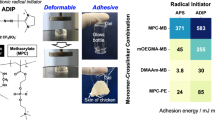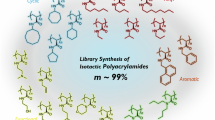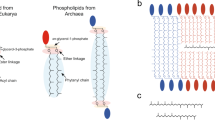Abstract
Polysilsesquioxanes (PSQs) containing 4-chloromethylphenyl groups were prepared and used for introducing ethylxanthate groups. The obtained PSQs that contained benzyl xanthate structures (XAPSQs) were employed as macroinitiators for grafting acrylamide monomers. The use of XAPSQs for the radical polymerization with acryloylmorpholine (ACMO), N,N-dimethylacrylamide (DMAA) or N-isopropylacrylamide enabled the preparation of the respective grafted PSQ, in which no cross-linked product was formed. The results of the graft polymerizations from XAPSQs supported the interpretation that the reversible addition-fragmentation chain transfer polymerization progressed effectively using the technique known as macromolecular design via the interchange of xanthate. The introduction of polymerized ACMO and DMAA units provided an amphiphilic property to the grafted PSQ. In addition, the PSQs containing poly(ACMO) components showed reversible hydrophobic aggregation behavior at approximately 80°C in aqueous solution.
Similar content being viewed by others
Log in or create a free account to read this content
Gain free access to this article, as well as selected content from this journal and more on nature.com
or
References
Baney, R. H. & Cao, X. In Silicon-Containing Polymers (eds Johns R.G., Ando W., Chojnowski J. (Kluwer, Dordrecht, 2000).
Sprung, M. M. & Guenther, F. O. The hydrolysis of n-amyltriethoxysilane and phenyltrimethoxysilane. J. Polym. Sci. 28, 17–34 (1958).
Brown, J. F., Vogt, L. H., Katchman, A., Eustance, J. W., Kaiser, K. M. & Krantz, K. W. Double chain polymers of phenylsilsesquioxane. J. Am. Chem. Soc. 82, 6194–6195 (1960).
Roy, D. A. & Shea, K. J. Bridged polysilsesquioxanes. Highly porous hybrid organic-inorganic materials. Chem. Rev. 95, 1431–1442 (1995).
Lee, J-K., Char, K., Rhee, H-W., Ro, H. W., Y. Yoo, D. & Yoon, D. Synthetic control of molecular weight and microstructure of processible poly(methylsilsesquioxane)s for low-dielectric thin film applications. Polymer 42, 9085–9089 (2001).
Chang, C-L. & Ma, C-C. M. Synthesis, characterization, and properties of novel ladderlike phosphorus-containing polysilsesquioxanes. J. Polym. Sci. Part A 41, 1371–1379 (2003).
Yamamoto, S., Yasuda, N., Ueyama, A., Adachi, H. & Ishikawa, M. Mechanism for the formation of poly(phenylsilsesquioxane). Macromolecules 37, 2775–2778 (2004).
Gunji, T., Iizuka, Y., Arimitsu, K. & Abe, Y. Preparation and properties of alkoxy(methyl)silsesquioxanes as coating agents. J. Polym. Sci. Part A 42, 3676–3684 (2004).
Khiterer, M., Loy, D. A., Cornelius, C. J., Fujimoto, C. H., Small, J. H., Mcintire, T. M. & Shea, K. J. Hybrid polyelectrolyte materials for fuel cell applications: design, synthesis, and evaluation of proton-conducting bridged polysilsesquioxane. Chem. Mater. 18, 3665–3673 (2006).
Fina, A., Tabuani, D. & Camio, G. Polypropylene-polysilsesquioxane blends. Euro. Polym. J. 46, 14–23 (2010).
Qin, Y., Ren, H., Zhu, F., Zhang, L., Shang, C., Wei, Z. & Luo, M. Preparation of POSS-based organic-inorganic hybrid mesoporous materials networks through shiff base chemistry. Euro. Polym. J. 47, 853–860 (2011).
Chuang, W-P., Sheen, Y-C., Weit, S-M., Teng, C-C., Yen, M-Y. & Ma, C-C. M. Phase segregation polymethylsilsesquioxane in antireflection coatings. Macromolecules 44, 4872–4878 (2011).
Pyun, J. & Matyjaszewski, K. Synthesis of nanocomposite organic/inorganic hybrid materials using controlled/“living” radical polymerization. Chem. Mater 13, 3436–3448 (2001).
Kim, K-M., Keum, D-K. & Chujo, Y. Organic-inorganic polymer hybrids using polyoxazoline initiated by functionalized silsesquioxane. Macromolecules 36, 867–875 (2003).
Fu, B. X., Lee, A. & Haddad, T. S. Styrene-butadiene-styrene triblock copolymers modified with polyhedral oligomeric silsesquioxanes. Macromolecules 37, 5211–5218 (2004).
Kessler, D., Teutsch, C. & Theato, P. Synthesis of processable inorganic-organic hybrid polymers based on poly(silsesquioxanes): grafting from polymerization using ATRP. Langmuir 209, 1437–1446 (2008).
Wang, R., Wang, W-Z., Lu, S. & Liu, T. Controlled radical synthesis of fluorene-based blue-light-emitting coplymer nanospheres with core-shell structure via assembly. Macromol. Chem. Phys 42, 4993–5000 (2009).
Belon, C., Chemtob, A., Crouyxé-Barghorn, C., Righholet, S., Le Houérou, V. & Gauthier, C. Combination of radical and cationic photoprocesses for the single-step synthesis of inorganic hybrid films. J. Polym. Sci. Part A 48, 4150–4158 (2010).
Yoshitake, H., Nakajima, H., Oumi, Y. & Sano, T. Control of spacing between aminoalkyl functions by mesostructural transition in a polysilsesquioxane lamellar assembly. J. Mater. Chem. 20, 2024–2032 (2010).
Chaikittisilp, W., Kubo, M., Moteki, T., Sugawara-Narutaki, A., Shimojima, A. & Okubo, T. Porous siloxane-organic hybrid with ultrahigh surface area through simultaneous polymerization-destruction of functionalized cubic siloxane cages. J. Am. Chem. Soc. 133, 13832–13835 (2011).
Moriya, O., Yamamoto, S., Kumon, S., Kageyama, T., Kimura, A. & Sugizaki, T. Synthesis of graft copolymer from polysilsesquioxane initiated by photoiniferter. Chem. Lett. 33, 224–225 (2004).
Sugizaki, T., Kashio, M., Kimura, A., Yamamoto, S. & Moriya, O. Graft polymerization of polysilsesquioxane containing chloromethylphenyl groups by atom transfer radical polymerization. J. Polym. Sci. Part A 42, 4212–4221 (2004).
Masuda, T., Yamamoto, S., Moriya, O., Kashio, M. & Sugizaki, T. Preparation of amphiphilic polysilsesquioxane by grafting of block copolymer of acrylamide monomers. Polym. J. 39, 220–229 (2007).
Masuda, T., Yamamoto, S., Moriya, O., Kashio, M. & Sugizaki, T. Preparation of stimuli-responsive polysilsesquioxane grafted block copolymer of acrylamide monomers. Polym. J. 40, 126–136 (2008).
Kashio, M., Sugizaki, T., Yamamoto, S., Matsuoa, T. & Moriya, O. Ring-opening polymerization of ɛ-caprolactone by base catalyst for synthesis of grafted polysilsesquioxane. Polymer 49, 3250–3255 (2008).
Kashio, M., Sugizaki, T., Tanaka, Y., Yamamoto, S., Moriya, O. & Nishikubo, T. Synthesis of grafted polysilsesquioxane by ring-opening polymerization of lactide and trimethylene carbonate. Polym. J. 43, 525–530 (2011).
Ninomiya, A. & Yoshimura, H. Synthesis and photosensitivity of acryloylmorpholine copolymers with a pendant (meth)acryloyl group. J. Appl. Polym. Sci. 87, 684–692.
Rivas, B. L., Villegas, S. & Ruf, B. Water-insoluble polymers containing amine, sulfonic acid, and carboxylic acid groups: synthesis, characterization, and metal-ion-retention properties. J. Appl. Polym. Sci. 99, 3266–3274.
Jo, Y. S., van der Vlies, A. J., Gantz, J., Antonijevie, S., Demurtas, D., Velluto, D. & Hubell, J. A. RAFT homo- and copolymerization of n-acryloyl-morpholine, piperidine, and azocane and their self-assembled structures. Macromolecules 41, 1140–1150 (2008).
Takahashi, A. & Hisatomi, H. Hydrophilic monomers surpress the adsorption of plasma protein onto a poly(vinylidene fluoride) membrane. Mol. Med. Rep 2, 749–752 (2009).
Chiefari, J., Chong, Y. K., Ercole, F., Krstina, J., Jeffery, J., Le, T. P. T., Mayadunne, R. T. A., Meijs, G. F., Moad, C. L., Moad, G., Rizzardo, E. & Thang, S. H. Living free-radical polymerization by reversible addition-fragmentation chain transfer: the raft process. Macromolecules 31, 5559–5562 (1998).
Charmot, D., Corpart, P., Adam, H., Zard, S. Z., Biadatti, T. & Bouhadir, G. Controlled radical polymerization in dispersed media. Macromol. Sym 150, 23–32 (2000).
Perrier, S. & Takolpuckdee, P. Macromolecular design via reversible addition-fragmentation chain transfer (raft)/xanthates (madix) polymerization. J. Polym. Sci, Part A: Polym. Chem 43, 5347–5393 (2005).
Smith, A. E., Xu, X. & McCormick, C. L. Stimuli-responsive amphiphilic (co)polymers via RAFT polymerization. Prog. Polym. Sci. 35, 45–93 (2010).
Beija, M., Marty, J. -D. & Destarac, M. RAFT/MADIX polymers for the preparation of polymer/inorganic nanohybrids. Prog. Polym. Sci. 36, 845–886 (2011).
Chen, G. H. & Hoffman, A. S. Graft copolymers that exhibit temperature-induced phase transitions over a wide range of pH. Nature 373, 49–52 (1995).
Kikuchi, A. & Okano, T. Pulsatile drug release control using hydrogels. Adv. Drug. Deliver. Rev 54, 53–77 (2002).
Sugihara, S., Kanaoka, S. & Aoshima, S. Double thermosensitive diblock copolymers of vinyl ethers with pendant oxyethylene groups: unique physical gelation. Macromolecules 38, 1919–1927 (2005).
Meyer, S. & Richtering, W. Influence of polymerization conditions on the structure of temperature sensitive poly(N-iso-propylacrylamid) (PNiPAM) microgels. Macromolecules 38, 1517–1519 (2005).
Skrabania, K., Kristen, J., Laschewsky, A., Akdemir, O., Hoth, A. & Lutz., J-F. Design, synthesis, and aqueous aggregation behavior of nonionic single and multiple thermoresponsive polymers. Langmuir 23, 84–93 (2007).
Author information
Authors and Affiliations
Corresponding author
Rights and permissions
About this article
Cite this article
Kashio, M., Sugizaki, T., Miyasaka, Y. et al. Graft polymerization of acrylamide monomers from polysilsesquioxane containing xanthate groups. Polym J 44, 1214–1221 (2012). https://doi.org/10.1038/pj.2012.91
Received:
Revised:
Accepted:
Published:
Issue date:
DOI: https://doi.org/10.1038/pj.2012.91



